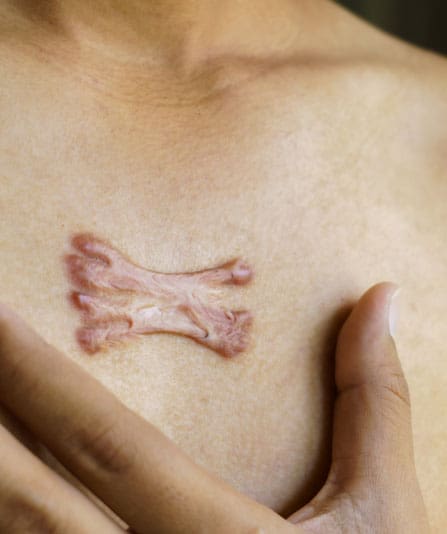What Are Keloid Scars?
Keloids are thick, often shiny growths of scar tissue that can form after even very minor skin damage, such as ear piercing, acne spots, or body piercing. They are more common in individuals with a darker skin tone, and risk factors include genetics, skin injury, and improper wound closure. Hypertrophic and keloid scars may cause discomfort, including a burning sensation, discolouration, and itching.
Effective Treatment Options for Keloids
While keloids can be stubborn, there are multiple treatment options available to manage and improve their appearance:
- Corticosteroid or steroid injections – Injectable steroids are the first-line treatment to reduce inflammation and flatten the raised scar.
- Surgical excision – Careful keloid removal followed by post-operative radiotherapy to reduce the chance of recurrence
- Laser therapy – Laser treatments target scar pigmentation and texture while stimulating healthy skin regeneration
- Silicone gel sheeting or silicone sheets – Applied to the keloid to flatten and soothe the scar over time.
- Compression dressings or pressure garments – Used post-surgery or post-injury to reduce collagen synthesis and flatten scars.
- Radiation therapy – In some persistent or large keloid cases, it is used following surgical thread closure to prevent new keloid growth
Our treatment approach is based on individual factors, including scar size, location (e.g., upper chest, shoulders, or earlobes), and your overall health and healing process. Whether you need corticosteroid injections or the surgical removal of a keloid, can be discussed with an expert.
To ask about other treatments, such as a skin graft, subcision, or microneedling, plus more, call our clinic today at 07908422412. We can talk about your treatment options, and growth factors that cause the human body to develop small keloids, as well as ways to reduce the risk factors associated with keloid scars and ways to reduce irritation in areas that feel itchy.
Prevention and Long-Term Management
Understanding how to prevent developing keloids is equally important. Avoiding unnecessary skin damage, properly managing wound edges, and applying silicone gel during the healing process can help reduce the risk of keloid returning and prevent keloids in new areas. For high-risk patients, our specialists may advise therapeutic management such as skin biopsy, silicone dressings, keloid surgery, or even laser treatment early in the scarring process.
Consult with a Keloid Expert
If you suffer from keloid scars, or hypertrophic scars, or are seeking guidance on keloid treatment, Goutos London is here to help. Our clinic combines surgical precision with cutting-edge therapies to treat keloids effectively and safely. Book a consultation today and take the first step toward restoring your skin’s natural balance and comfort.
Click here, call 07908422412, or email INFO@GOUTOSLONDON.COM today, and find out how Mr Ioannis Goutos and his team of experts at Goutos London can help you.









